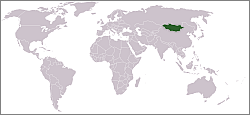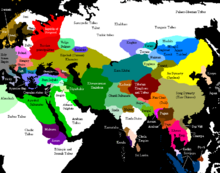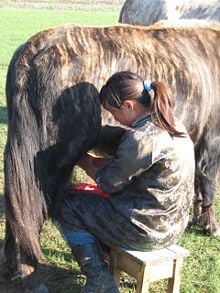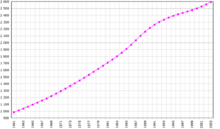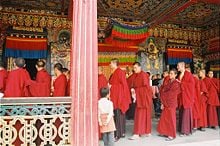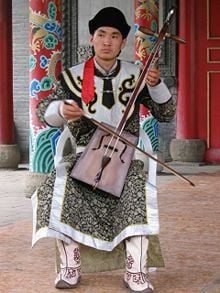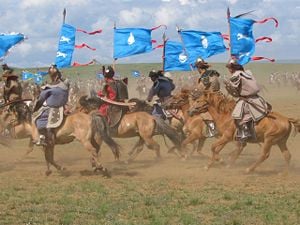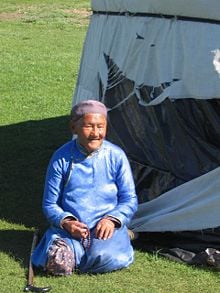Mongolia
Mongγol ulus Монгол улс Mongol uls Mongolia |
||||||
|---|---|---|---|---|---|---|
|
||||||
| Anthem: "Монгол улсын төрийн дуулал" National anthem of Mongolia |
||||||
| Capital (and largest city) | Ulan Bator 47°55′N 106°53′E | |||||
| Official languages | Mongolian | |||||
| Official script(s) | Mongolian Cyrillic Mongolian script[1] |
|||||
| Ethnic groups (2010) | 95.35% Mongol, 3.86% Kazakh 0.8% others[2] |
|||||
| Demonym | Mongol, Mongolian[3] | |||||
| Government | Parliamentary republic | |||||
| - | President | Tsakhiagiin Elbegdorj | ||||
| - | Prime Minister | Sükhbaataryn Batbold | ||||
| Legislature | State Great Khural | |||||
| Formation | ||||||
| - | Formation of the Hunnic Empire | 209 B.C.E. | ||||
| - | Formation of the Mongol Empire | 1206 | ||||
| - | Independence declared (from Qing Dynasty) | December 29, 1911 | ||||
| Area | ||||||
| - | Total | 1,564,115.75 km² (19th) 603,909 sq mi |
||||
| - | Water (%) | 0.68[4] | ||||
| Population | ||||||
| - | 2010 census | 2,754,685[5] | ||||
| - | Density | 1.76/km² (236th) 5.03/sq mi |
||||
| GDP (PPP) | 2010 estimate | |||||
| - | Total | $11.018 billion[6] | ||||
| - | Per capita | $4,006[6] | ||||
| GDP (nominal) | 2010 estimate | |||||
| - | Total | $6.125 billion[6] | ||||
| - | Per capita | $2,227[6] | ||||
| Gini (2002) | 32.8 (medium) | |||||
| Currency | Tögrög (MNT) |
|||||
| Time zone | (UTC+7 to +8[7][8][9]) | |||||
| Internet TLD | .mn | |||||
| Calling code | +976 | |||||
Mongolia (Mongolian: Монгол Улс) is a landlocked country located in East Asia with a population of nearly three million. Mongolia is also sometimes classified as being a part of Central Asia, as well as being termed part of "inner Asia." It is bordered by Russia to the north and China to the south. Its capital and largest city is Ulaanbaatar.
Mongolia was the center of the Mongol Empire in the thirteenth century and was later ruled by China during the Manchu Qing Dynasty from the end of the eighteenth century until 1921, when a satellite government was formed by the Soviet Union. Following the end of the Cold War, and after the fall of communism in Mongolia in 1990, Mongolia adopted democracy. A new democratic constitution, ratified in 1992, officially marked the birth of Mongolia as a democratic nation, making it one of the world's youngest democracies.
At 1,564,116 sq. km., Mongolia is the largest and most sparsely-populated landlocked country in the world. The country contains very little arable land, as much of its area is covered by arid and unproductive steppes with mountains to the north and west and the Gobi Desert to the south. Approximately 30 percent of the country's 2.8 million people are nomadic or semi-nomadic. The predominant religion in Mongolia is Tibetan Buddhism, and the majority of its citizens are of Mongol ethnicity, though many Kazakhs and Tuvans also live in the country, especially in the west. About one-third of the population lives in Ulaanbaatar.
The year 2006 marked the 800th anniversary of the Great Mongolian State that Genghis Khan (Chinggis Khaan) established in 1206, which not only united all the Mongolian tribes, but through conquest became the largest empire in history, spanning from Eastern Europe to the Pacific Ocean. The empire was the most progressive yet seen, expanding trade and cultural communication, granting universal religious freedom, abolishing feudal systems, and giving rise to a blossoming of civilization. Some scholars even credit the Mongol Empire for spurring the Renaissance in western Europe.[10]
History
A large number of ethnicities have inhabited Mongolia since prehistoric times. Most of these people were nomads who, from time to time, formed great confederations that rose to prominence. The first of these, the Xiongnu, were brought together to form a confederation by Modu Shanyu in 209 B.C.E. They defeated the Donghu, who had previously dominated in eastern Mongolia. The Xiongnu became the greatest enemy of China for the following three centuries. The Great Wall of China was built partly as defense against the Xiongnu. Marshal Meng Tian of the Qin Empire dispersed more than 300,000 soldiers along the Great Wall to prevent an expected invasion from the North. It is believed that after their decisive defeat by the Chinese in 428-431, some of the Xiongnu migrated West to become the Huns. After the Xiongnu migrated west, Rouran, a close relative of the Mongols, came to power before being defeated by the Gokturks, who then dominated Mongolia for centuries.
During the seventh and eighth centuries, Mongolia was controlled by Gokturks, who were succeeded by the ancestors of today's Uigur and then by the Khitan and Jurchen. By the tenth century, the country was populated predominantly by Mongols believed to be a branch of the Xianbei. During this period, the country was divided into numerous tribes linked through transient alliances. In the late twelfth century, a chieftain named Temujin united the Mongol tribes with the Naiman and Jurchen after a long struggle, and took the name of Genghis Khan. Starting in 1206, Genghis Khan and his successors consolidated and expanded the Mongol Empire into the largest contiguous land empire in world history. After Genghis Khan's death, the empire was divided into four kingdoms, or "Khanates." One of these, the "Great Khanate," comprised the Mongol homeland and China, and its emperors were known as the Yuan Dynasty. Its founder, Kublai Khan, set up his administrative center in present-day Beijing. After more than a century of power, the Yuan Dynasty was replaced by the Ming Dynasty in 1368, and the Mongol court fled north. The Ming armies pursued and defeated them in Mongolia, but did not conquer Mongolia.
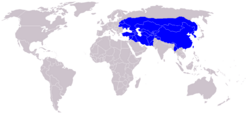
During the next few centuries, Mongolia was split between the Oirad in the west and the Khalkha in the east. Altan Khan united the Mongols briefly in 1571. After failing to defeat the Chinese, he made peace with the Ming Dynasty and instead attacked Tibet, eventually becoming a convert to Tibetan Buddhism.
During the seventeenth century, the Manchus rose to prominence in the east, and they conquered Inner Mongolia in 1636 and Outer Mongolia in 1691. For the next 200 years Mongolia was ruled by the Manchus, whose rulers became the Qing Dynasty. During this time, the Manchus maintained their control over Mongolia with a series of alliances and intermarriages, as well as military and economic control. Several emperors of the Qing Dynasty were born to Mongol mothers.
With the fall of the Qing Dynasty, Mongolia declared independence in 1911. The new country's territory was approximately that of the former Outer Mongolia. After the Bolshevik Revolution in Russia, Chinese troops led by Xu Shuzheng attacked and occupied the capital in 1919. Chinese rule did not last: Notorious Russian adventurer "Bloody" Baron Ungern, who had fought with the "Whites" (Ataman Semyonov) against the Red Army in Siberia, led his troops into Mongolia and forced a showdown with the Chinese in Ulaanbaatar. Ungern's cossacks triumphed, and he, in effect, briefly ruled Mongolia under the blessing of religious leader Bogd Khaan. But Ungern's triumph too was short-lived; he was chased out by the Red Army when it "liberated" Mongolia from feudalism and insured its political alignment with the Russian communists. In 1924, after the death of Bogd Khaan, the Mongolian People's Republic was established by the Soviets.
Alignment with Soviet Union
Mongolia was the first country in Asia to embrace communist rule and the first to disengage from it. In 1928, under the administration of Horloogiyn Choybalsan, forced, but productive, collectivization was instituted, and in 1937, Buddhist monasteries were destroyed, with more than 10,000 Buddhist monks killed in the process.
During the Soviet-Japanese Border War of 1939, the USSR defended Mongolia against Japan during the Battle of Halhin Gol. Mongolian forces also took part in the Soviet offensive against Japanese forces in Inner Mongolia in August 1945 (see Operation August Storm). The threat of Mongolian forces seizing parts of Inner Mongolia induced the Republic of China to recognize Outer Mongolia's independence, provided that a referendum was held. The referendum took place on October 20, 1945, with the electorate voting for independence.
The Chinese Kuomintang Government, which had long been considering Mongolia as a part of China, had to recognize the independence of the Mongolian People's Republic and signed the protocol in the establishment of diplomatic relations on February 13, 1946. Only three years later, in 1949, the People's Revolution in China led to the establishment of the People's Republic of China. This created favorable external conditions for strengthening the independence of the Mongolian People's Republic (MPR).
The Government of the MPR recognized the People's Republic of China and established diplomatic relations with them on October 6, 1949. The two countries concluded the Treaty in 1962 and pledged to respect each others independence and coexist peacefully.
Mongolia remained a Soviet satellite for nearly 70 years. In that time, the Soviets built much of Mongolia's infrastructure and industrial base and stationed military troops on the Chinese border.[11]
1990 democratic revolution
The introduction of perestroika and glasnost in the USSR by Soviet president Mikhail Gorbachev strongly influenced Mongolian politics even though Mongolia was a sovereign nation. The collapse of communism in Eastern Europe, combined with these two policies, were enough to lead to a peaceful democratic revolution in Mongolia in 1990. This, in turn, allowed Mongolia to begin engaging in economic and diplomatic relations with the Western world. The nation finished its transition from a communist state to a multi-party, free-market democracy with the ratification of a new constitution in 1992.
The new freedoms that came with sudden democratization brought blessings and curses. Religious and civic freedoms brought optimism and rediscovery of the rich cultural and historical Mongolian traditions, but losing Russia's economic subsidies as its prime trading partner brought tremendous challenges to the everyday economic survival of Mongolians at large. Mongolian-style democracy faced many of the same challenges that other former Soviet satellite nations have faced.
Many of Mongolia's democratic reforms were initiated with U.S. assistance. The United States had recognized Mongolia in 1987 and since has sought to expand cultural and economic ties. Mongolia’s profile was further raised by the 2005 visits of President George W. Bush and then-Secretary of Defense Donald Rumsfeld, who each praised Mongolia’s democratic reforms and aspirations as well as willingness to deploy its military forces for global peace-keeping missions (e.g., in Iraq). Both Russia and China now view Mongolia with some wariness as a pro-U.S. democracy in the midst of an otherwise authoritarian Eurasia.
Government and Administrative Divisions
Until June 27, 2004, the dominant party in Mongolia was the ex-communist Mongolian People's Revolutionary Party, or MPRP, which was formed by Mongolia's communist leaders after the end of the Cold War. The main opposition party was the Democratic Party or DP, which controlled a governing coalition from 1996 to 2000.
From 2000 to 2004, MPRP was back in power, but results of the 2004 elections required the establishment of the first-ever coalition government in Mongolia between the MPRP and MDC (Motherland Democratic Coalition). By January 2006, the fragile coalition broke up with the MPRP once again leading the government; however, the DP refused to take part in a new coalition. The next parliamentary elections are scheduled for June 2008.
Mongolia's constitution provides three requirements for taking office as President: The individual must be a native-born Mongolian, who is at least 45 years of age, and who has resided in Mongolia for five years prior to taking office. Nambaryn Enkhbayar became president of Mongolia in June 2005.
Mongolia uses a unicameral parliamentary system in which the president has a symbolic role and the government chosen by the legislature exercises executive power. The legislative arm, the State Great Hural, has one chamber with 76 seats and is chaired by the speaker of the house.
The prime minister is elected by the State Great Hural. The cabinet is then nominated by the prime minister in consultation with the president, and confirmed by the State Great Hural. Since January 2006, the Prime Minister has been Miegombyn Enkhbold.
The judges of the Supreme Court are nominated by a General Council of Courts and confirmed by the State Great Hural and the President. However, there is also a Constitutional Court, as the Supreme Court does not have jurisdiction to interpret the Constitution.
Mongolia is divided into 21 Aymguud (provinces) (sing. aimag or aymag) and one municipality (khot) with provincial status. The Aymguud are further sub-divided into 315 Somon ("districts") (sing. Sum).
Geography and climate
At 604,209 square miles (1,565,000 square kilometers), Mongolia is the world's 19th-largest country (after Iran). It is significantly larger than the next-largest country, Peru, and nearly as large as the U.S. state of Alaska.
The Mongolian heartland consists of relatively flat steppes. The southern portion of the country is taken up by the Gobi Desert, while the northern and western portions are mountainous. The highest point in Mongolia is Nayramadlin Orgil (Huyten Orgil) at 4,374 m (14,350 feet). Uvs Nuur Lake, shared with Tuva Republic in the Russian Federation, is a natural World Heritage Site.[12]
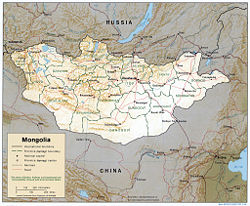
Most of the country is hot in the summer and extremely cold in the winter, with January averages dropping as low as -30ºC (-22ºF). The country is also subject to occasional harsh climatic conditions known as zud or dzud. Ulaanbaatar has the coldest average temperature of any national capital in the world.
Mongolia has a cold and arid climate of extremes with long, cold winters and short summers, during which most of its annual precipitation falls. The country averages 257 cloudless days a year, and it is usually at the center of a region of high atmospheric pressure. Precipitation is highest in the north (average of 20 to 35 centimeters per year) and lowest in the south, which receives 10 to 20 centimeters annually. The extreme south is the Gobi, some regions of which receive no precipitation at all in most years.
Economy
Mongolia's economy is centered on agriculture and mining. Mongolia has rich mineral resources, and copper, coal, molybdenum, tin, tungsten, and gold account for a large part of industrial production. In the 1990s, the disappearance of Soviet aid due to the fall of the Soviet Union accounted for the closing of many industrial facilities in Mongolia. Following decades of state-run enterprise, the economy began the painful transition to capitalism; in 2000-2002, opposition to privatization, as well as droughts and other natural disasters, contributed to a negative GDP growth. However, growth picked up in 2004 and 2005 with increases of 10.6 percent and 5.5 percent, respectively, largely due to the high price of commodities (gold and copper).
There are currently over 30,000 independent businesses in Mongolia, chiefly centered around the capital city. The majority of the population outside urban areas participate in subsistence herding; livestock typically consists of cows, sheep, goats, horses, and Bactrian camels. Agricultural crops include wheat, barley, vegetables, and other forage crops.
GDP per capita in 2005 was $1,900.[4] Although GDP has risen steadily since 2002, at the rate of 6.2 percent in an official 2005 estimate, the state is still working to overcome a sizable trade deficit. A massive ($11 billion) foreign debt to Russia was settled by the Mongolian government in December 2003, with final agreement in 2010, with a $250 million payment.[13] Mongolia joined the World Trade Organization in 1997, seeking to integrate itself in the Asian regional economies, and now it exports cashmere, minerals, and food products to Russia, the United States, China, Japan, Italy, and other countries.
Despite growth, the proportion of the population below the poverty line was estimated to be 36.1 percent in 2004, and both the unemployment rate and inflation rate were high at 6.7 percent and 10.9 percent, respectively.
Industrial sector
Industry currently accounts for 21.4 percent of GDP, approximately equal to the weight of the agriculture sector (20.4 percent). These industries include construction and construction materials, mining, oil, food and beverages, processing of animal products, and cashmere and natural fiber manufacturing. The industrial production growth rate was estimated to be 4.1 percent in 2002.
Tourism
In the late 1980s, tourism played a minor role in Mongolia's foreign economic relations. About 10,000 foreign visitors came from communist, North American, and West European countries annually.
A change in country's attitude toward tourism took place when the Tourism Law of Mongolia was enacted on May 5, 2000. The new law resulted in plans to raise services to the world standard and extensive measures to increase tourist arrivals in Mongolia and to create attractive tour options. There are currently 219 tourism operators in the country. Untouched nature, magnificent wildlife, ancient history, and the unique nomadic traditions and culture of the Mongols present great potential for the development of the Mongolian tourism industry, with special potential in eco-tourism, hunting, and fishing.
The number of tourists, now about 350,000 a year, is growing more than 10 percent annually. Hilton Hotels was scheduled to open a 240-room hotel in May 2008. Other five-star hotels are beginning to appear in Ulaanbaatar.
Infrastructure
Mongolia has a relatively small and undeveloped infrastructure in terms of roads and electricity. Due to the nomadic nature of some parts of the population, the vast majority of roadways are unpaved. However, investment from South Korea and other countries have helped add more paved roads and electricity access to remote locations in Mongolia. The Trans-Siberian Railway passes through Mongolia between China and Russia. There are 48 airports throughout the country, including one international airport in Ulaanbaatar, with service to China, Korea, Japan, Germany, Russia, and other countries. The air transport company of Mongolia is MIAT.
The petroleum products and electricity used to power the infrastructure are in large part (80 percent) imported from Russia, which makes Mongolia vulnerable to supply shortages.
Demographics
Though the majority of Mongolian citizens are of Mongol descent, there are small populations of Kazakh, Tuvan, and Tungus peoples. Mongolia's population growth rate is estimated at 1.54 percent (2000 census). About two-thirds of the total population is under age 30, 36 percent of whom are under 14. This relatively young and rapidly growing population has, as in many developing countries, placed strains on Mongolia's economy.
Life in sparsely populated Mongolia has become more urbanized. Nearly half of the people live in the capital and in other provincial centers. Semi-nomadic life still predominates in the countryside where many families stay in villages during the cold winters and live in yurts (gers) during the summer, though agricultural communities that are settled year-round are becoming more common.
Ethnic Mongols account for about 85 percent of the population and consist of Khalkha and other groups, all distinguished primarily by dialects of the Mongol language. The Khalkha make up 90 percent of the ethnic Mongol population. The remaining 10 percent include Durbet Mongols and others in the north and Dariganga Mongols in the east. Turkic speakers (Kazakhs, Tuvans, and Uyghurs) constitute 7 percent of Mongolia's population, and the rest are Tungusic-speakers, Chinese, and Russians. Most, but not all, Russians left the country following the withdrawal of economic aid and collapse of the Soviet Union in 1991.
Language
The official language of Mongolia is Khalkha Mongol, which uses the Cyrillic alphabet, but there is a variety of different dialects across the country. Mongol is an Altaic language—from the Altaic Mountains of Central Asia, a language family comprising the Turkic, Tungusic, and Mongolic subfamilies—and is related to Turkic Uzbek, Turkish, Tatar and Kazakh, and possibly Korean and Japanese. In the far western parts of the country, where there is more ethnic diversity, primarily due to populations of ethnic Tuvans and Kazakhs, the Tuvan language and Kazakh language, among others, are also spoken. In the northern parts of the country Russian is frequently spoken. Furthermore, the Mongolian government has worked to encourage the learning of English as a second language by having it replace Russian in schools.
Religion
Aside from brief periods of Islam and Christianity, various forms of Shamanism have been widely practiced throughout the history of what is now modern day Mongolia, as such beliefs were common among nomadic people in Asian history. Tibetan Buddhism is the predominant religion practiced in Mongolia today while ancient shamanistic practices and traditions are still observed in rural areas. Islam and Christianity are minority faiths in this region.
Throughout much of the twentieth century, the communist government repressed the religious practices of the Mongolian people. Horloogiyn Choybalsan complied with the orders of Soviet dictator Joseph Stalin, destroying almost all of Mongolia's over 700 Buddhist monasteries and killing thousands of monks. The fall of communism in 1991 restored the legality of public religious practice, and Tibetan Buddhism, which had been the predominant religion in the region before the rise of communism, again rose to become the most widely practiced religion in Mongolia. The end of religious repression in the 1990s also allowed for other religions, such as Christianity, to spread in the country.
Education
During much of 1970s and 1980s, the communist government emphasized large education initiatives, and as a result the public school system was very powerful and prevalent. Chemistry, the Russian language, and mathematics were emphasized. After the 1990 democratic revolution, study of different foreign languages became popular. Mongolia has a very high literacy rate, with 96 percent able to read and write. After the democratic revolution, many private colleges and schools were created, offering a wide variety of studies, especially in the English language. Mongolia has named English the second official language of Mongolia, replacing Russian.
Mongolia also has large state universities such as the National University of Mongolia and the Mongolian University of Science and Technology, plus many other institutions and colleges are educating Mongolia's next generation throughout the city of Ulaanbaatar.
Health
Health care in Mongolia is not as available or affordable as it once was under the Communist system. Under the new free market economy the average citizens must fend for themselves. People who live in the countryside as nomadic herders experience the greatest risk, without health care resources and health care education.
In a population of about 2.6 million people, 65 percent are in the 16-64 age bracket and about 4 percent are over 64. HIV/AIDS has not made a significant impact, with only about 16 reported cases in the whole country.
The birthrate is 2.26 per woman, and that rate is increasing. Average life expectancy is 63 years, and the infant mortality rate is at 6 percent.
Culture
The main cultural festival is Naadam, which celebrates the anniversary of Mongolian independence from China. It is held annually on July 11-13, and consists of three Mongolian traditional sports: Archery, horse-racing (over long stretches of open country, not the short racing around a track practiced in the West), and wrestling. One popular game is the "flicking" of sheep foot bones at a target several feet away, using a flipping motion of the finger to send the small bone flying at a target and to attempt to knock the target bone off the platform.
Khoomii, or "throat singing," is a popular music form, particularly in western Mongolia. Mongolians love to entertain by singing for one another in family and larger public settings.
In the simpler lifestyle of people who live in the countryside, the capacity to experience great joy amid their sparse existence is observed with awe by visitors from the West. The hospitality of the inhabitants to visitors to the inhospitable landscapes of Mongolia is legendary.
Since the great changes that have taken place in Mongolian governance since the 1990s, the nomadic people's values and way of life have been accelerating toward extinction. Factors such as their herds' susceptibility to disease, unfavorable environmental developments, and the lure of a better life in urban centers are contributing to the downfall of Mongolia's pastoral culture. Urban life often does not offer what these people expect when they arrive on the doorstep of a town or city. The outskirts of the capital city of Ulaanbaatar has overflow suburbs of gers, the traditional tents in which the nomadic country people dwell.
The Mongolian national flag has an ornate symbol in the leftmost bar that is a Buddhist icon called a soyonbo. It represents the sun, moon, stars, and heavens per standard cosmological symbology abstracted from traditional Tibetan thangka paintings.
Impact of Mongolian civilization
Mongolia was an unchallenged superpower centuries ago. Today it is a country deserving of the world's attention in the way it survived under communism and then reasserted its religious faith while seeking its place in the modern world. Mongolia's Buddhist adherents endured seven decades of communist brutality that aimed to exterminate religion, and it is reemerging as a country proud of its religious heritage. Given the economic difficulties the country faced after the collapse of the Soviet Union, as it transitioned to a market economy, Mongolians nonetheless have made the rebuilding of temples and monasteries a top priority.
In 2006, Mongolia celebrated 800 years since Genghis Khan established the unified kingdom that made it a superpower. His successful integration of different political, economic, religious, and cultural systems and traditions of those he conquered was without precedent in history. However he may be viewed as a conqueror, it is undeniable he was a major force in opening lines of cultural communication and trade between Asia and the West. For example, important technologies developed in China, such as gunpowder, the magnetic compass, mechanical clock, and printing press made their way to Europe as a result of his conquests. Scholars even credit the Mongol Empire for spurring the Renaissance in western Europe
Evidence of the Mongolian legacy from well before Genghis Khan can be found around the world—throughout not only Asia, but parts of Africa, Europe, and especially the Western Hemisphere. Early Mongolian tribesmen journeyed to the Americas thousands of years ago across the Bering Sea land bridge; their descendants are found from the Inuits of Alaska and Canada through the Amerindians of the southern cone of South America. Moreover, descendants of the Mongolian lineage after Genghis Khan's conquests are found throughout his far-flung empire and beyond, verified by genetic documentation.
Notes
This article incorporates text from the Library of Congress Countries Study, which is in the public domain.
- ↑ "Official Documents to be in Mongolian Script", 'UB Post', 2011-06-21. Retrieved November 24, 2011.
- ↑ Mongolia National Census 2010 Provision Results. National Statistical Office of Mongolia (in Mongolian.) Retrieved November 24, 2011.
- ↑ "Mongolian" is included minorities like Kazakhs or Tuvans.
- ↑ 4.0 4.1 Central Intelligence Agency, Mongolia The World Factbook.
- ↑ Date: (2011-06-13). Momgolia National Census 2010 Preliminary Results. National Statistical Office of Mongolia. Retrieved November 24, 2011.
- ↑ 6.0 6.1 6.2 6.3 Error on call to template:cite web: Parameters url and title must be specified. International Monetary Fund.
- ↑ Mongolia Standard Time is GMT (UTC) +8, some areas of Mongolia use GMT (UTC) + 7 (Time Temperature.com). Retrieved November 24, 2011.
- ↑ The Mongolian government has chosen not to move to Summer Time (World Time Zone.com). Retrieved November 24, 2011.
- ↑ Mongolian Time Zones. Retrieved November 24, 2011.
- ↑ Jack Weatherford, Genghis Khan and the Making of the Modern World (New York, NY: Random House, 2004, ISBN 0609809644).
- ↑ Russia Re-establishing Relations with Mongolia Stratfor.com. Retrieved April 17, 2009.
- ↑ World Heritage Site, Mongolian Matters. Retrieved July 9, 2007.
- ↑ U.S. Department of State, Mongolia. Retrieved November 24, 2011.
Photo Credit
Susan Bradbury. The Sound Essence Project. USA. Photos of Mongolia (4). 2006.
ReferencesISBN links support NWE through referral fees
- Bold, Bat-Ochir. Mongolian Nomadic Society: A Reconstruction of the 'Medieval' History of Mongolia. Palgrave Macmillan, 2001. ISBN 0312228279
- De Francis, John. Chinese Agent in Mongolia by Ma Ho-T'ien. Johns Hopkins University Press, 1949. ISBN 0801801591
- Hibbert, Reginald and Ann. Letters from Mongolia. Radcliffe Press, 2005. ISBN 1850435782
- Haslund, Henning. In Secret Mongolia (Mystic Traveller). Adventures Unlimited Press, 1995. ISBN 0932813275
- Kaplonski, Chris. Truth, History and Politics in Mongolia. RoutledgeCurzon, 2004. ISBN 0415307988
- Mongolian Civilization and World Peace: The Core Values of the Mongolian Peoples and Their Relevance to World Peace. Tarrytown, NY: Universal Peace Federation, 2007. ISBN 978-1930549555
- Weatherford, Jack. Genghis Khan and the Making of the Modern World. New York: Random House, 2004. ISBN 0609809644
External links
All links retrieved November 9, 2022.
- US Department of State—Mongolia includes Background Notes, Country Study and major reports.
- Mongololia Photographic Stories by Michel Setboun.
- Plants of Mongolia.
- Buddhism Rebounds in Mongolia.
Credits
New World Encyclopedia writers and editors rewrote and completed the Wikipedia article in accordance with New World Encyclopedia standards. This article abides by terms of the Creative Commons CC-by-sa 3.0 License (CC-by-sa), which may be used and disseminated with proper attribution. Credit is due under the terms of this license that can reference both the New World Encyclopedia contributors and the selfless volunteer contributors of the Wikimedia Foundation. To cite this article click here for a list of acceptable citing formats.The history of earlier contributions by wikipedians is accessible to researchers here:
The history of this article since it was imported to New World Encyclopedia:
Note: Some restrictions may apply to use of individual images which are separately licensed.


